It’s very cold here in northern Utah (8 degrees F. as I type) and there’s lots of snow on the ground – ideal conditions for photographing hunting Northern Harriers. And yesterday morning everything was covered with a thick layer of hoar-frost which turned the marshes into a frosty fairyland.
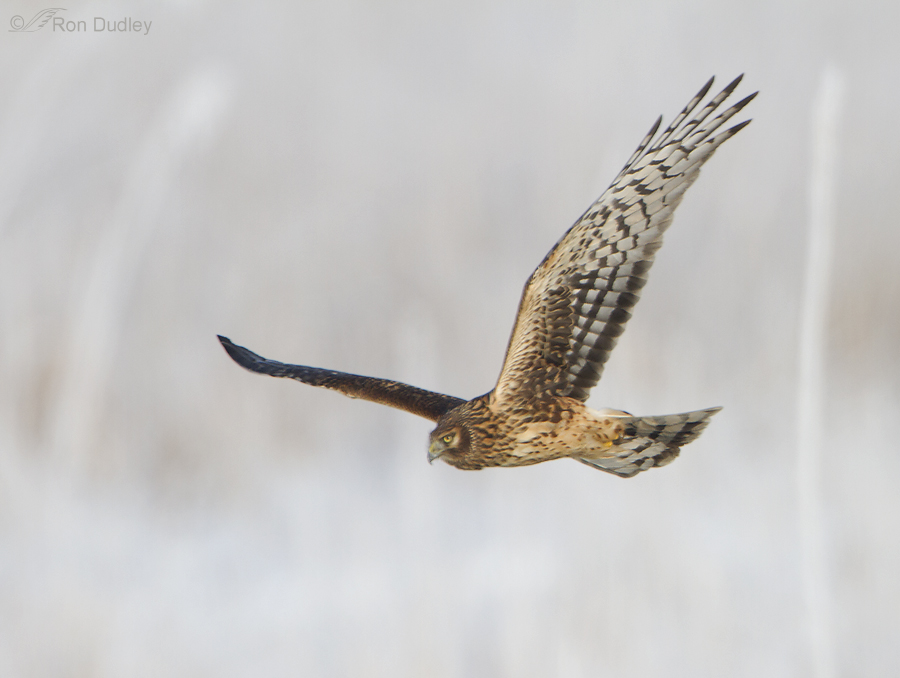
I was able to get lots of shots of this particular bird and in the field I didn’t even notice that there was anything unusual about it. Most of the images were flight shots and there just isn’t time pay attention to detail when you’re concentrating so hard on keeping the bird in the frame and in focus.
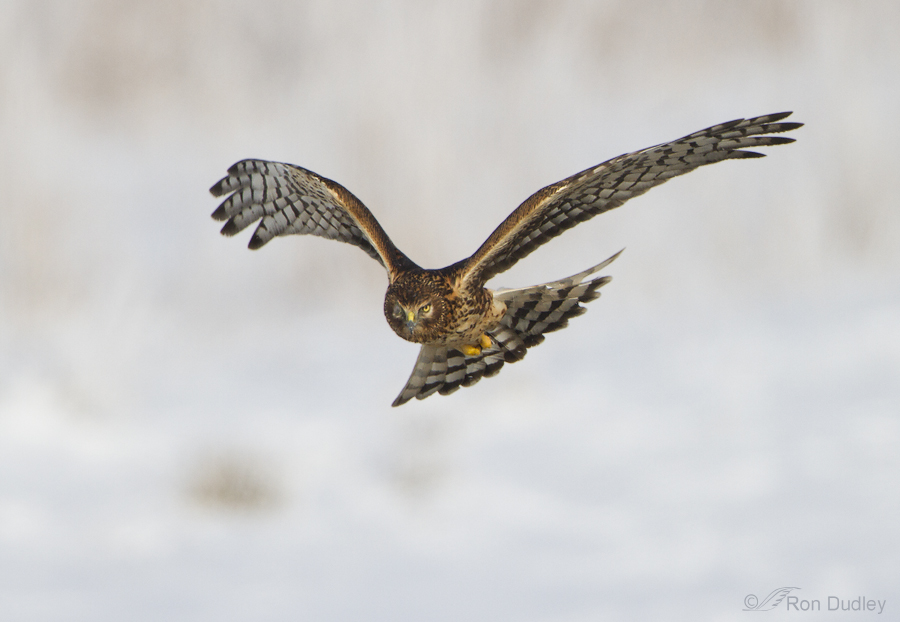
But when I got home and started reviewing my images I was taken aback. Something’s definitely going on with the right eye of this bird. At first I thought it might be just the closed nictitating membrane but I have dozens of shots of this bird and the eye is the same in all of them. It’s definitely not a normal membrane, if it’s the membrane at all.
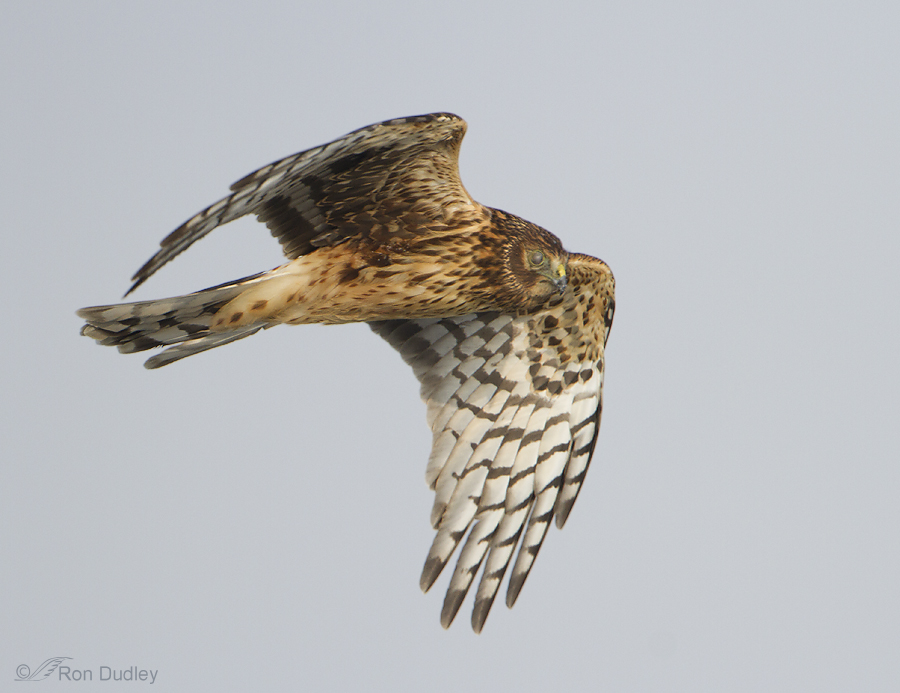
A better look at the right eye.
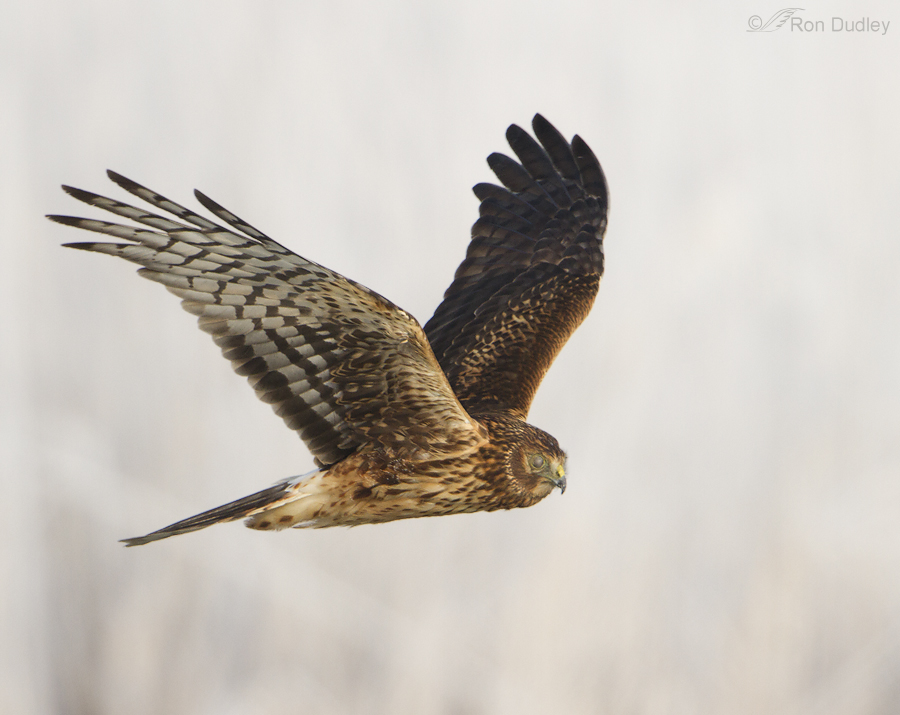
This is probably the sharpest, most detailed image I was able to get of the bird.
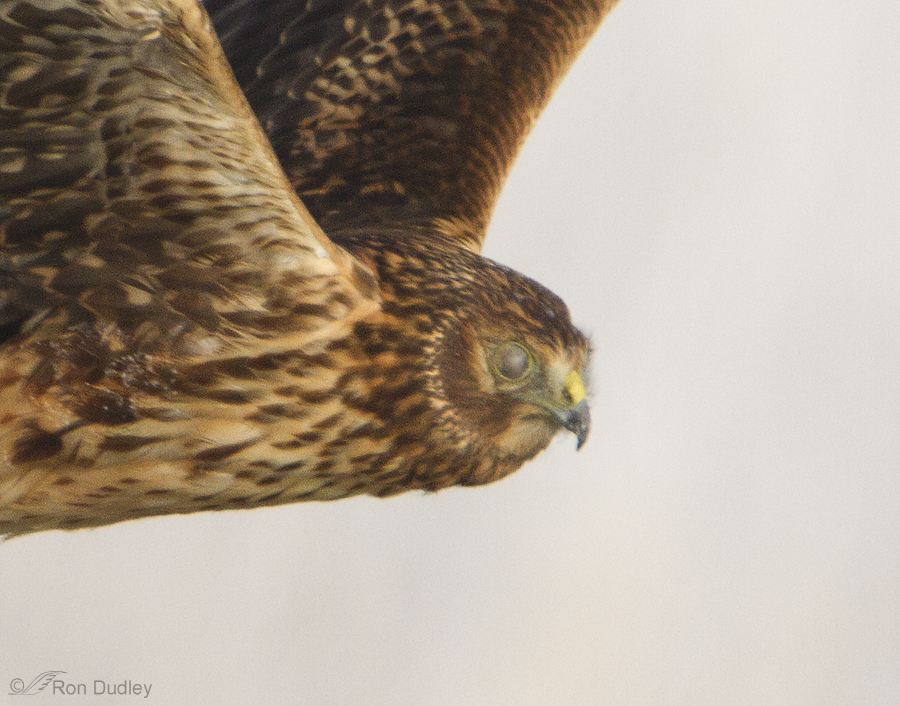
An extreme crop of the previous image to show the best detail I could manage. To my untrained eye it looks like there may be some kind of fungal growth in and around the eye that may have discolored the eye ring and nictitating membrane and closed the membrane permanently, but that’s only a guess.
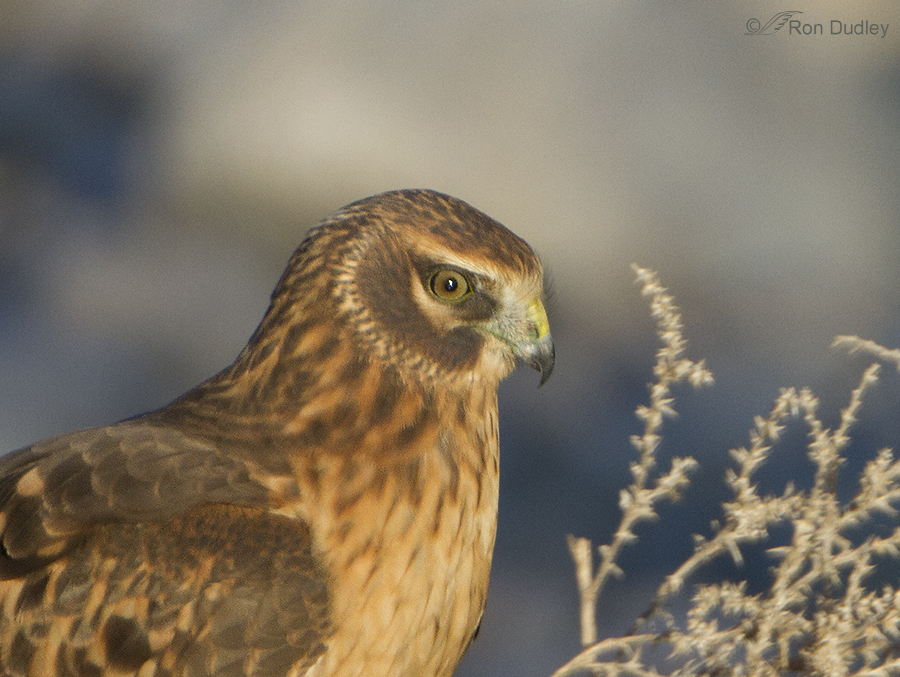
A normal eye (huge crop) for comparison.

I watched this bird, on and off, for perhaps 20 minutes and it’s behavior seemed completely normal – here it’s in a typical hunting flight posture as it scans below for voles. It’s interaction with other harriers also seemed normal.
I’m extremely curious about what’s going on with this eye. I’ve spent hundreds of hours photographing harriers and have never seen anything like it. I know that several of my readers are rehabbers and falconers so I wondered if any of you have experienced such a thing in the birds you’ve dealt with or treated. Or anyone else… thoughts?
Ron


would they be here in Pennsylvania?
I must have missed this in the commotion… have you seen him/her again?
No, I haven’t, Nicole. But I haven’t been out shooting much either, due to the weather and poor light.
Amazing that it can still (apparently) hunt effectively with one eye (apparently) blinded — depth perception being so critical!
It surprised me too, Katie.
If I have seen one of these birds, I have seen a thousand. They are wonderfully common in the Plains States where I grew up. In my all too brief time in working with raptors I have had the opportunity to handle exactly ONE…and it was a female like this one. She footed me twice in the blink of an eye with no more emotion than a windshield impacting a junebug! Amazingly well adapted rodent traps.
I noted in the 7th and final photo that her head was cocked slightly, as if to compensate for the loss of the one eye. I wonder if this is an old injury and she has learned to compensate? By the way, That photo gives me quite a thrill as it clearly shows the flight structures of the wing; the golden/bronze midwing area where soaring lift is accomplished and each individual primary flight feather out on the wing tips where the power stroke propels them in their pursuit of voles, and lastly the striking banded pattern of the splayed out tail. I am sure that is the very last image to cross the retinas of many a field mouse!
Thank you so kindly for sharing, Mr. Dudly. Please let us know if you see her again?
Thanks very much, John. And I certainly will report back if I see this bird again.
Ron, it was characteristically good of you to notice this eye problem and to seek input to help the bird. Thank you for that sensitivity. My guess is that some trauma caused ulceration of the cornea, and that any opportunistic fungal or bacterial infection (which looks very likely on the surface of the eye) is secondary to that damage and to interference with the cleansing and lubricating work of the nictitans. That “inner eyelid” is crucial to maintaining the health of the eye and seems entirely missing or dysfunctional in this case. Of course I would defer to Louise’s much wider experience, but my feeling is that such an infection will soon become systemic if it hasn’t already. I have cared for owls with progressively serious eye problems, alas, and it’s not a type of malady that’s apt to get better on its own.
As for hunting by hearing alone, even most owls cannot do that. Only the “hearing-dominant” species like the Barn Owl and the Great Gray, Saw-whet, and Barred Owls (for example) have ears that are large enough, directional enough, and perhaps most importantly ~asymmetrically-placed~ enough on the vertical axis of the owl’s head to permit triangulation of a sound source by hearing alone. It isn’t hard to identify such owls by observation: they have extremely large facial discs to capture and direct sound into each of the two ears for comparison of the sound’s intensity and arrival time. Further, their facial discs are equally extensive ABOVE and below the eye, and have a highly sculptured (not fluffy) appearance.
Now the Northern Harrier does have something of a facial disc, certainly in comparison to most diurnal raptors, and gains some additional hearing function as a result. But their discs at best seem no better developed than, say, a Great Horned Owl or a Screech Owl, both of whom are counted among the “visually-dominant” owls and who most certainly cannot hunt by hearing alone. Indeed, they rely primarily on vision to locate and capture prey.
More can be said about the extraordinary hearing abilities of different types of owls. Indeed, some interesting research has given us even better appreciation of the refinement of the auditory apparatus in the hearing dominant owls (specialized to hunt in dense woodlands or under heavy snow cover!), but my point here is much simpler. I don’t
think your harrier has a long future unless caught, treated by a board-certified veterinary ophthalmologist and then hopefully re-released into her current habitat. The sooner this is done, the better the chances for saving the eye. If the bird is already perhaps subsisting on carrion, it shouldn’t be too hard for a falconer or rehabber to entice her to visit a harmless bal-chatri trap. As for the oft-repeated maxim about letting nature take its course, I can only say that IMO humans have altered the natural world so utterly to suit ourselves that we can no longer invoke “nature” as a reason not to intervene to help wild creatures whose maladies more often than not will be found to have our fingerprints on them somewhere.
Thanks for caring about this bird. There are rehabbers in your area who can probably help her, hopefully before it’s too late.
Thank you so much for your in-depth comment, Maya.
Regarding “hunting by hearing alone” – I’m certainly no ornithologist or veterinarian and I defer to your knowledge on the subject. I made my comment based on this statement about harriers from The Birds of North America, Online” out of Cornell – “Owl-like facial ruff and facial structures facilitate prey detection by sound, even in absence of visual cues”.
I’m reluctant to attempt to get involved in trapping this bird because of the philosophies of land managers in the area, as mentioned in a previous comment. And actually that policy is one that I personally have no quarrel with.
I have nothing to add – but have been fascinated at the images and the responses. Thank you Ron, and a big thank you to everyone commenting as well.
Thanks, Elephant’s Child. And I agree with you – the comments are extremely interesting and helpful.
It looks like fungus or mold. Perhaps the eye was injured while diving into the grass to get a vole and fungal spores got into the damaged eyelid. Poor thing.
I thought it looked like fungus too, Tana.
Incredible! I like Louise’ response.
I have to once again thank you for sharing this, and for being skilled enough to capture the image. As an amateur biologist, exposure to these things really helps accelerate my learning. I’m indebted to you!
Thank you for the very nice comment, Bryce. Still hoping to run into you out in the field soon…
It’s impossible to tell from these shots, but clearly something is wrong. A cataract is usually inside the lens – you can often see it through the pupil as a milky blue and it obscures your ability to check out the retina, pectin, etc. Cataracts can come from trauma. TO me, however, this looks like something on the surface of the eye – we HAVE seen fungal growths in raptors that, as far as we could tell, arose from the dysfunction of the nictitans … without that periodic moistening and cleaning, the surface of the eyed dried out and an opportunistic fungal growth got started. We have a red-tailed hawk that came in like that – in the end, despite long term treatment of the fungus, given the fact that the nictitans wasn’t working, we opted to remove the eye at the recommendation of a veterinary ophthalmologist.
Such a dry eye could also promote a bacterial infection – and in the crop, tho fuzzy, it looks like maybe there’s some exudate accumulating on the lateral aspect of the eye. It could be the result of a scratch or lesion on the eye from, say a thorn or a prey, that has now ulcerated the cornea. We’ve also received a gyrfalcon with a massive, crusty infection of the eye – but it looked raised and thick and coarse (which it was) and it totally obscured any sign of the eye itself. (That eye was removed also.) We kept those two birds for education because most diurnal birds really need both eyes.
Whatever is going on with the harrier, she has a better chance of surviving with a damaged eye than most diurnal raptors, as she can fall back on her hearing somewhat – as long as any infection doesn’t go systemic. It might be treatable, however, if someone could trap her. Could you see if she was successfully hunting, Ron? Unfortunately there’s no way to look at a bird and tell if it’s thin – the thinner they are, the more they poof their feathers out for warmth and look fatter. Any chance one of your new falconry friends could try to trap her? I can put you in touch with some Utah rehabbers…
Thank you, Louise, for your knowledgeable and thoughtful evaluation of the situation. I didn’t see this bird actually capture prey but I did see it, along with several other harriers, feeding on a dead carp along the edge of a pond (when it gets extremely cold around here it’s typical for harriers to feed on dead fish). I photographed this bird at a state WMA and it’s the philosophy of the land managers around here to let naturally occurring situations play themselves out naturally. I was at the same pond this morning and didn’t see this bird but it’s a large WMA with lots of harriers so that wouldn’t be unexpected. And I think you’re right – since this is a harrier, its chances of survival with compromised sight are much better than they would be with any other raptor since harriers (like some owls) can detect prey using auditory cues alone.
Like BWJones, my first thought was that it looked like cataracts in humans (a complete layperson’s observation and not based on any experience). I’m glad to see it appears to be hunting normally.
They are fabulous shots. Have you tried contacting Cornell ornithology? They are really good.
Looks like a cataract to me.